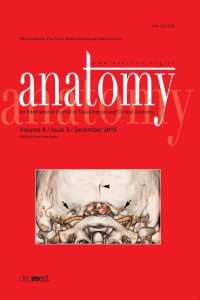RADIOLOGICAL AND ANATOMICAL EVALUATION OF THE POSTERIOR CONDYLAR CANAL, POSTERIOR CONDYLAR VEIN AND OCCIPITAL FORAMEN
Abstract
Objectives: This study was carried out to make morphometric and radiological analyses of the occipital foramen (OF), posterior condylar canal (PCC), posterior condylar vein (PCV), and occipital emissary vein (OEV).
Methods: Morphometric analyses were performed on 91 adult human occipital bones and radiological analyses on computed tomography (CT) angiography images of 221 patients. PCC length and mean diameters of the internal and external orifices of PCC were measured and the number of OF on both sides was recorded for bony specimens. Prevalence of PCV and PCV size were investigated using CT angiography.
Results: PCCs were observed in 60 bones (66%) on the left and 60 bones (66%) on the right side. Mean PCC length was 10.85 ±3.41 and 9.77±3.55 on the left and right sides, consequently. Mean internal orifice diameter was 3.87±1.99 mm on the left and 3.31±4.43 mm on the right side; mean external orifice diameter was 4.02±1.59 mm on the left and 3.89±1.52 mm on the right side. The majority of PCCs (75%-81.6%) had 2-5 mm diameter; only 5-13.3% were small in size (<2mm). In CT angiography, PCV was not identified in 45(22.5%) patients. PCVs were located bilaterally in 114 (57%) and unilaterally
in 41(20.5%) patients. Only 4.3% of PCVs (n=17) were large in size, the majority (27.5%) were medium-sized and 35.8% small-sized.
Conclusion: This study will contribute to the limited body of research on OF, PCC, PCV, and OEV as a guide to surgical interventions
for pathologies of the posterior cranial fossa such as tumors and injuries.
Keywords
computed tomography angiography emissary vein occipital foramen posterior condylar canal posterior condylar vein
References
- Mortaazavi M, Tubbs S, Reich S, Verma K, Shoja M, Zurada A, Benninger B, Loukas M, Gadol C. Anatomy and pathology of the cranial emissary veins: a review with surgical implications. Neurosurgery 2012;70:1312–9.
- Pekcevik Y, Sahin H, Pekcevik R. Prevalence of clinically important posterior fossa emissary veins on CT angiography. J Neurosci Rural Pract 2014;5:135–8.
- Ginsberg LE. The posterior condylar canal. Am J Neuroradiol 1994;15:969–72.
- Reis CVS, Deshmukh V, Zabramski JM, Crusius M, Desmukh P, Spetzler RF, Preul MC. Anatomy of the mastoid emissary vein and venous system of posterior neck region: neurosurgical implications. Neurosurgery 2007;61:193–201.
- Matsushima K, Kawashima M, Matsushima T, Hiraishi T, Noguchi T, Kuraoka A. Posterior condylar canals and posterior condylar emissary veins – A microsurgical and CT anatomical study. Neurosurg Rev 2014;37:115–26.
- Pekcevik Y, Pekcevik R. Why should we report posterior fossa emissary veins? Diagn Interv Radiol 2014;20:78–81.
- Matsushima T, Matsukado K, Natori Y, Inamura T, Hitotsumatsu T, Fukui M. Surgery on a saccular vertabral artery-posterior inferior cerebellar artery aneurysm via the transcondylar fossa (supracondylar transjugular tubercle) approach or the transcondylar approaches. J Neurosurg 2001;95:268–74.
- Thomas M, Barker N. Dose-optimised 3D CT evaluation. Toshiba Vis J 2008;12:54–61.
- Lambert, Paul R, Cantrell, Robert W. Objective tinnitus in association
- with an abnormal posterior condylar emissary vein. Am J Otol 1986;7:204–7.
- Forte V, Turner A, Liu P. Objective tinnitus associated with abnormal mastoid emissary vein. J Otolaryngol 1989;18:232–5.
- Weissman JL. Condylar canal vein: unfamiliar normal structure as
- seen at CT and MR imaging. Radiology 1994;190:81–4.
Abstract
References
- Mortaazavi M, Tubbs S, Reich S, Verma K, Shoja M, Zurada A, Benninger B, Loukas M, Gadol C. Anatomy and pathology of the cranial emissary veins: a review with surgical implications. Neurosurgery 2012;70:1312–9.
- Pekcevik Y, Sahin H, Pekcevik R. Prevalence of clinically important posterior fossa emissary veins on CT angiography. J Neurosci Rural Pract 2014;5:135–8.
- Ginsberg LE. The posterior condylar canal. Am J Neuroradiol 1994;15:969–72.
- Reis CVS, Deshmukh V, Zabramski JM, Crusius M, Desmukh P, Spetzler RF, Preul MC. Anatomy of the mastoid emissary vein and venous system of posterior neck region: neurosurgical implications. Neurosurgery 2007;61:193–201.
- Matsushima K, Kawashima M, Matsushima T, Hiraishi T, Noguchi T, Kuraoka A. Posterior condylar canals and posterior condylar emissary veins – A microsurgical and CT anatomical study. Neurosurg Rev 2014;37:115–26.
- Pekcevik Y, Pekcevik R. Why should we report posterior fossa emissary veins? Diagn Interv Radiol 2014;20:78–81.
- Matsushima T, Matsukado K, Natori Y, Inamura T, Hitotsumatsu T, Fukui M. Surgery on a saccular vertabral artery-posterior inferior cerebellar artery aneurysm via the transcondylar fossa (supracondylar transjugular tubercle) approach or the transcondylar approaches. J Neurosurg 2001;95:268–74.
- Thomas M, Barker N. Dose-optimised 3D CT evaluation. Toshiba Vis J 2008;12:54–61.
- Lambert, Paul R, Cantrell, Robert W. Objective tinnitus in association
- with an abnormal posterior condylar emissary vein. Am J Otol 1986;7:204–7.
- Forte V, Turner A, Liu P. Objective tinnitus associated with abnormal mastoid emissary vein. J Otolaryngol 1989;18:232–5.
- Weissman JL. Condylar canal vein: unfamiliar normal structure as
- seen at CT and MR imaging. Radiology 1994;190:81–4.
Details
| Primary Language | English |
|---|---|
| Subjects | Health Care Administration |
| Journal Section | Original Articles |
| Authors | |
| Publication Date | February 1, 2016 |
| Published in Issue | Year 2015 Volume: 9 Issue: 3 |
Cite
Anatomy is the official journal of Turkish Society of Anatomy and Clinical Anatomy (TSACA).


